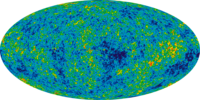
Photo from wikipedia
We analyse the stellar kinematics of the z = 0.169 brightest cluster galaxy in Abell 1201, using integral field observations acquired with the Multi-Unit Spectroscopic Explorer on the Very Large… Click to show full abstract
We analyse the stellar kinematics of the z = 0.169 brightest cluster galaxy in Abell 1201, using integral field observations acquired with the Multi-Unit Spectroscopic Explorer on the Very Large Telescope. This galaxy has a gravitationally lensed arc located at unusually small radius (∼5 kpc), allowing us to constrain the mass distribution using lensing and stellar dynamical information over the same radial range. We measure a velocity dispersion profile which is nearly flat at σ ≈ 285 km s−1 in the inner ∼5 kpc, and then rises steadily to σ ≈ 360 km s−1 at ∼30 kpc. We analyse the kinematics using axisymmetric Jeans models, finding that the data require both a significant dark matter halo (to fit the rising outer profile) and a compact central component, with mass Mcen ≈ 2.5 × 1010 M⊙ (to fit the flat σ in the inner regions). The latter component could represent a supermassive black hole, in which case it would be among the largest known to date. Alternatively Mcen could describe excess mass associated with a gradient in the stellar mass-to-light ratio. Imposing a standard Navarro–Frenk–White (NFW) dark matter density profile, we recover a stellar mass-to-light ratio ϒ, which is consistent with a Milky Way-like initial mass function (IMF). By anchoring the models using the lensing mass constraint, we break the degeneracy between ϒ and the inner slope γ of the dark matter profile, finding γ = 1.0 ± 0.1, consistent with the NFW form. We show that our results are quite sensitive to the treatment of the central mass in the models. Neglecting Mcen biases the results towards both a heavier-than-Salpeter IMF and a shallower-than-NFW dark matter slope (γ ≈ 0.5).
Journal Title: Monthly Notices of the Royal Astronomical Society
Year Published: 2017
Link to full text (if available)
Share on Social Media: Sign Up to like & get
recommendations!